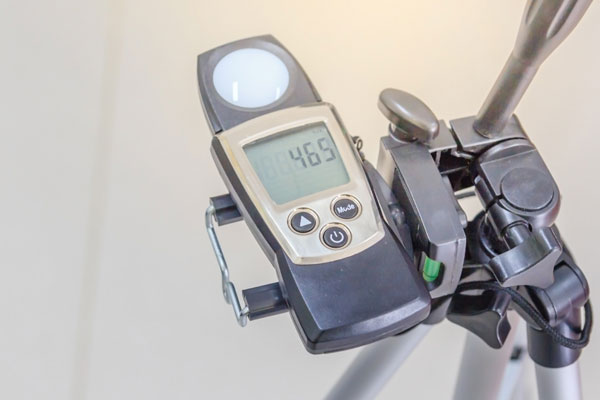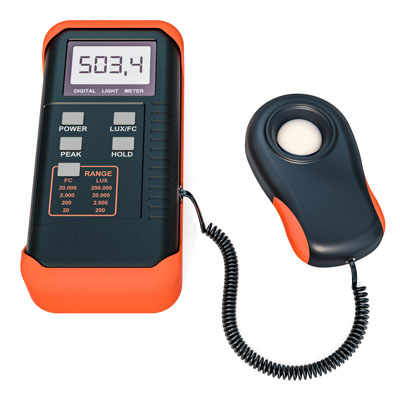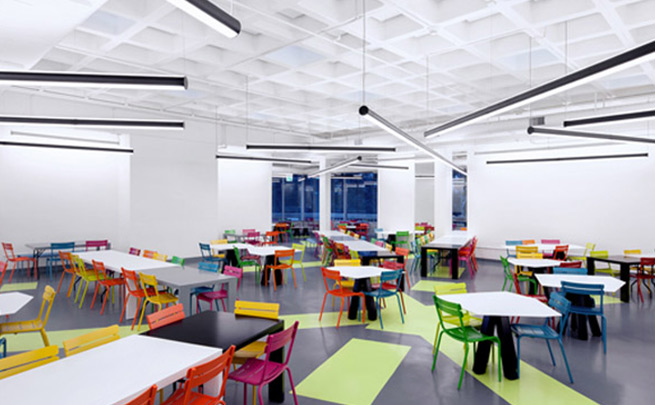In architectural lighting, light intensity or light output is measured to understand whether a particular light source provides enough light for an intended application. The lighting industry has well-established light level recommendations for a wide range of applications and space types. It is especially useful to understand light intensity in order to properly evaluate whether or not a space has adequate lighting conditions.
This article will cover a few basic principles related to light intensity – how to measure light intensity, the difference is between lumens and illuminance (and what they mean), plus we will discuss the ways in which artificial light has become so critical to our daily lives and well-being.
What is the Best Metric to Measure Light Intensity?

Illuminance is the metric that is used to measure the light intensity within a space. It is measured in footcandles or lux – it is the amount of light (lumens) falling on a surface (over any given square foot or square meter). Therefore, light intensity is measured in terms of lumens per square foot (footcandles) or lumens per square meter (lux). Measuring the amount of light that falls on a surface allows us to evaluate if we have sufficient light to perform various visual tasks.
Now let’s look deeper at how we measure illuminance – We start by looking at the two fundamental lighting units of measure: lumens and illuminance (footcandles/lux). It is common to get these two confused by definition or simply using one inaccurately in place of the other – so let’s iron this out.
What are Lumens?
Lumens (lm) are the unit of measurement we use to quantify the amount of visible light the human eye can see. The luminous flux of a particular light source is measured in lumens. You many have noticed when you buy light bulbs for your house that they indicate lumen output. The higher the lumen output, the ‘brighter’ or higher intensity the light source; the lower the lumen output, the less bright or lower intensity the light source.
When you purchase light bulbs based on their intensity or brightness, it is lumens you‘re after, not watts – watts simply determine a bulb’s energy consumption. By understanding lumens, we can explore other lighting metrics such as illuminance (footcandles/lux) and how this plays a key role in assessing the intensity of a light source.
A light source, like an incandescent bulb for example, emits light in all directions, of which the total measurement is displayed as luminous flux (something we’ll get to shortly). Now, lumens are simply a unit of light, but when put into context over a given surface area, they become especially a more useful metric. Which moves us onto illuminance (footcandles/lux).
What is Lux?
Lux is simply the unit of measure used to describe the number of lumens falling on a square foot (footcandles) or square meter (lux) of a surface. So let’s say you have a light source with 1,000 lumens. If all of those 1,000 lumens are spread over a surface area of 1 square meter, you’d have an illuminance of 1,000 lux – i.e. the brightness of an overcast day. But what if we spread this over 10x the area i.e. 10 square meters? Well, the illuminance or lux would decrease to a less intense and dimmer 100 lux. We use the same approach for footcandles, only our units are lumens per square foot.
The reason we measure light intensity is to ensure a certain “standard” of illumination is met. it makes a valuable difference for a photographer (whose work is specifically centered around light) as it would in surgical theater or other indoor environments such as offices.
What is a Footcandle?
A footcandle is a measure of light intensity – it’s the number of lumen per square foot. Now, you might be thinking we already covered lux, so why add in this metric? Different people use different metrics and for different reasons. Simply put, where 1 lux equals 1 lumen in a square meter, 1 footcandle equals one lumen per square foot.
What is Luminous Flux?
Luminous flux is how to measure the perceived power or total amount of light output from a light source. When the number of lumens – the unit-amount of visible light a human eye can see, is used to measure the intensity of a light source. A one-meter sq. surface area is required (lux) to determine the luminous flux value.
Common Light Measurements
There are several types of lighting metrics and measurements used in the lighting industry. So far, we’ve covered measurements related to light intensity – lumens, footcandles and lux.
While these are useful to lighting experts, how do these terms relate to the real world? We need a little context. A typical classroom, for example, is recommended to have a light level of around 30-50 footcandles or 300-500 lux. Compare this to a professional laboratory which the lighting standards recommend have a light level of 75-120 footcandles or 750-1200 lux. The differences in recommended light levels are published by the IESNA (Illuminating Engineers Society of North America). The recommendations are based on years of visual testing to determine how much light the human eye needs to properly see different tasks with varying levels of detail. You can see from this example how specific environments have very different light level requirements.
To further explain this, you might be thinking about the biggest natural light source we have – the sun. Examples of common light levels:
- Bright Summer Day: 100,000 Lux (~10,000 footcandles)
- Full Daylight: 10,000 Lux (~1,000 footcandles)
- Overcast Day: 1,000 Lux (~100 footcandles)
- Traditional Office Lighting: 300-500 Lux (30-50 footcandles)
- Common Stairway: 50-100 Lux (5-10 footcandles)
- Twilight: 10 Lux (1 footcandle)
- Full Moon: <1 Lux (<0.1 footcandle)
What Meter Should I Use to Measure Light Intensity?
Lighting professionals use a light meter (also called an illuminance meter or lux meter) to measure the amount of light in a space/on a particular work surface. The light meter has a sensor that measures the light falling on it and provides the user with a measurable illuminance reading.
These handheld devices are commonly used by photographers to help calculate proper light exposure. However, they are also an essential tool that are used to measure and verify light levels in the built environment. Light meters are an especially useful tool if you are measuring light for safety or over-illumination, which cause eye strain and waste energy.
An added advantage of using a lux meter is that they can be calibrated. Why is this important? Consider how one person’s eyesight will determine certain wavelengths of light differently from the next. This means one person could determine a light source as being more or less intense since they perceive, or “see”, certain wavelengths differently. Add to this, different wavelengths emit different intensities of light.
This is why lux meters are configured to CIE standard illuminant A. A standard lux meter is essential to measure incandescent lighting, but what about LED lighting? To measure light intensity from LED lighting, you would use an LED light meter.
LED lighting has become increasingly common in commercial environments because of energy-efficiency, longevity, color temperature tuning, safety, and low maintenance. But LEDs produce white light in a different way to incandescent or fluorescent lighting, so it’s important to use the correct meter.
How to Measure Light Intensity Using a Light Meter

Using a light (lux) meter is the best way to measure light intensity – it gives us the ability to choose the optimal light intensity for an environment.
1. Measure Ambient Light In the Room
To begin, turn off any lighting in the room you’re about to measure. Turn on the light meter to establish what’s known as the baseline measurement – the ambient light.
This means you’re able to see how much the existing lighting adds to the room once the lights are then turned on.
2. Turn On the Lights, Take Your Measurement
From a central area of the space, ensure your light meter is set up to record your new reading. Remember not to rush – allow the lighting a few moments to reach full brightness (especially if you’re measuring light from CFLs).
3. Note Your Differential Reading
Simply subtract the ambient light level from the illuminated level – known as the differential (or delta) measurement, this is the amount of light the existing luminaires produce. With this light measurement unit, you can asses how it compares to the optimal lighting levels required.
4. Check Other Areas of a Room
For open office lighting or a corridor, the reading you get from your light meter should, in theory, be consistent. However, it might be worth checking any potential “blind” spots just to be sure you have consistency.
How Light Intensity Affects Functioning
Light intensity affects the way humans live, work and interact. More recently researchers have discovered how light affects our health and well-being. Research has shown that while standard artificial light meets our visual needs, it is not sufficient to provide proper biological signals that our bodies and brains need and can even have a negative impact on our long-term health. The reason being, people now spend the majority of their lives indoors – we’ve lost our connection to the sun and the solar day and no longer receive the critical light signals our bodies and brains need to promote better sleep and daytime alertness. We live in indoor environments that are too dim for our brains to identify as daytime and too bright at night for our brains to recognize as nighttime. We’ve lost our tie to our natural circadian cycle. For example, think about the brightly-lit grocery store you go to late in the evening or the dim lecture hall or conference room you might spend the middle of your day – this is completely the opposite of the light signals around which our bodies evolved.
Our modern lifestyles have reached the point where most of us spend around 87% of our time indoors. This means most of our “daylight” exposure is provided almost entirely by artificial lighting.
Without proper daylight exposure and because we remain more active in brighter environments at night, our sleep-wake cycles, which are directly linked to our circadian rhythms and melatonin production (the key sleep hormone) – become dysregulated. In order to get adequate and restful sleep which promotes daytime wakefulness and increased energy levels, mood and productivity; we need a well-functioning circadian rhythm. When this happens, we have improved sleep quality, allowing our circadian systems to repair both our bodies and our minds.
Studies have also shown that proper daytime light signals also affect serotonin (1), the precursor to melatonin. Serotonin helps us feel positive, calm, and productive – something we get from adequate daylight exposure and it is why Seasonal Affective Disorder (SAD) is such an issue throughout the extended darkness of our winter months!
The same study on the ‘Benefits of Sunlight’’ explains:
“The light we get from being outside on a summer day can be a thousand times brighter than we’re ever likely to experience indoors,” says melatonin researcher Russel J. Reiter – University of Texas Health Science Center.
“For this reason, it’s important that people who work indoors get outside periodically, and moreover that we all try to sleep in total darkness. This can have a major impact on melatonin rhythms and can result in improvements in mood, energy, and sleep quality.”
When we have access to sunlight each day, we’re healthier for it which means better outcomes for people and businesses – a company’s workforce that is well-rested at night is healthier, happier, and therefore more productive. Think about a time you’ve gone camping, hiking, or just spent the entire day outside – many times we find ourselves able to sleep better and more soundly after those experiences.
What is Circadian Lighting or Human Centric Lighting?

Circadian Lighting, also referred to as Human Centric Lighting (HCL), focuses on the lighting for human health and well-being and how we can use artificial light to provide the benefits of natural daylight. Until recently artificial lighting has focused on the human visual system, circadian lighting addresses the needs of the human biology and the human circadian system – the goal is to provide light that helps people to feel more alert, happier and productive during the day and improve sleep at night. When designing work environments, the benefits of circadian lighting or HCL can help promote well-being and cohesion among workers.
How to Choose the Ideal Light Intensity
Different spaces require different levels and light intensity. Establishing proper light levels not only allows us to see and perform tasks, but light intensity also provides subconscious visual cues that help with wayfinding and visual hierarchy within a space. You may not realize it, but even lighting in a corporate environment is often used to create a sense of “company culture.” So, how do you choose the ideal light intensity?
The most holistic approach is to consider the different uses the space will have, the ages of the people who are likely to use the space, and how long they might occupy each space.
Take a typical office environment, the recommended light level for the open office is around 30 footcandles (average) or 300 lux (average). However, it does not make sense, nor is it comfortable, to have the same light intensity level everywhere.
Let’s think about conference rooms or meeting rooms, for example. Presentations or high-engagement meetings would require a different light intensity and as compared to an informal team-working project.
Conference rooms may need 30 footcandles (300lux) for face-to-face meetings, but you also might have video presentations where you need the light intensity to be dimmed so you can see the projection screen or imagery more clearly. With most spaces, it is important to have layers of light and a lighting solution that’s versatile and human-centric, responding to the needs of the occupants. Some meeting rooms are meant for quick catch-ups and others are used for all-day training. If these spaces do not have access to daylight, it becomes extremely important to think about how circadian lighting can be used to help improve the wellness of these spaces.
Another environment for which interior light intensity is an important factor is classrooms. Learning is a highly visual experience, so appropriate light solutions should work in-line with the physical environment. We must consider horizontal tasks (the amount of light needed on desks) and vertical tasks (the amount of light needed to see writing on whiteboards). In general, 30 footcandles (300 lux) in the horizontal plane is recommended for a typical classroom.
In a school environment we also want to consider methods for reducing glare while maintaining consistent light levels so all students can see. In addition, research has shown that childrend and adolescents who receive proper morning light signals have improved performance, alertness, and reduced hyperactivity.
Finally, let’s look at hospitals and health centers. Hospitals are complicated spaces to light, there are a variety of occupants that have conflicting lighting needs – patients may need low light levels, while nurses need the light to see what they are doing. The lighting needs of daytime nurses versus night shift nurses is also a challenge.
Patient care areas need high quality light so that medical professionals can properly see veins and skin tone to assess any potential issues related to cyanosis or sepsis.
In addition, we know that daylight is so important to human health, but when you’re sick and immobilized, you cannot get outside to receive the much-needed health benefits of daylight. This makes providing circadian lighting for patient care areas even more important. In addition, the medical staff also benefit greatly from lighting circadian lighting to help promote strong daytime circadian signals.
If we focus on patient rooms, providing a healthy, restful environment is important for patient recovery. Generally, 10 footcandles (100 lux) is a comfortable and lower light intensity for resting.
But what if the patient wants to read – a patient might need the light levels a little higher – around 20 footcandles (200 lux). However, we also need to consider the needs of the medical professionals – patient rooms also have a separate exam light that can be turned on and off as needed to allow for bedside examinations, and provide higher light levels – up to 50-75 footcandles or 500-750 lux. In addition, when the patient is sleeping, the medical staff may need to come into the room to take vitals and they will need a task light that can provide 10 footcandles (100lx), ideally without bothering the patient.
The importance of choice in light-intensity, using layers of light for visual comfort, as well as implementing circadian lighting technology is clear – it’s at the heart of the circadian lighting technology BIOS human lighting has spent years developing using scientific data-research to create biology-first solutions.
(1) M. Nathaniel Mead, (April, 2008), ‘Benefits of Sunlight: A Bright Spot for Human Health’, Environ Health Perspect. <https://www.ncbi.nlm.nih.gov/pmc/articles/PMC2290997/>




